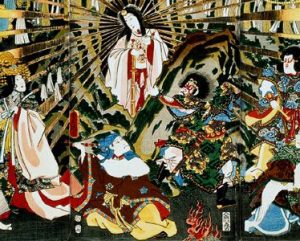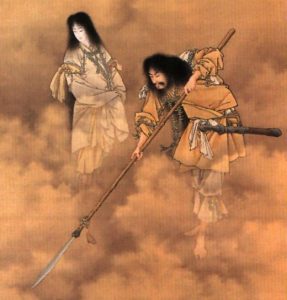This week, with Women’s History Month as our inspiration, we’re focusing on goddess in some of the lesser-known indigenous traditions. Yesterday, we featured two Hawaiian goddesses: Pele and Poli’ahu. Today, we explore two Shinto goddesses.
Shinto, which means “Way of the Gods,” is Japan’s traditional religion. While the Japanese are becoming increasingly secular, a huge percentage still participate in Shinto practices. Shinto temple rituals are especially popular for weddings and following the birth of a baby, which is why over 80,000 Shinto temples and priests still remain on the island-nation.

Shinto beliefs revolve around spirits, called kami, that manifest throughout nature and are intertwined with humanity. Since Japan’s name means “sun origin,” we’ll start with the sun goddess, Amaterasu. She is, perhaps, the most important deity in the Japanese/Shinto pantheon, and her story is full of conflicts and long-standing feuds with the other members of her deity clan, particularly her two younger brothers — Tsukuyomi, god of the moon/night, and Susanoo, god of the storms/sea. For example, according to legend, Amaterasu originally shared the sky with Tsukuyomi. When the goddess of food grossed him out, Tsukuyomi killed her, which prompted Amaterasu to split from him. And that’s how day and night separated.
Amaterasu’s quarrel with Susanoo was much more elaborate. For some reason that I could not ascertain, Susanoo threw a flayed horse (which means the skin had been removed) at Amaterasu while she was weaving with her sister. The horse wreaked havoc on the place and, in the ensuing chaos, the sister was killed. Amaterasu retreated to a cave which plunged the world in darkness. The other deities hatched an elaborate plan that included a jeweled tree with a mirror in the center to get Amaterasu to reveal herself. Eventually, Amaterasu flooded the world with light once again, and the jewels and the mirror (along with a sword of Susanoo’s) were given to Amaterasu’s grandson, Ninigi, when he became ruler of the earthly realm.
This myth lives on even today. These three items are said to represent Japan’s three primary virtues (jewels/benevolence, mirror/wisdom, and sword/valor). They are privately presented to the Emperor by Shinto priests during the enthronement ceremony, and some still claim that Japanese Emperors are direct descendants of Amaterasu.

Izanami, through a series of mythological circumstances, is the goddess of both creation and death. She is also responsible, in a round-about way, for the birth of Amaterasu.
Izanami and her male counterpart, Izanagi, were given a special spear by their ancestor deities. When they stood on the “floating bridge of heaven” and stirred the primordial sea below, they created the first island. The pair then decided to unite. Their first child was deformed, so he was set adrift in a boat, but they went on to successfully mate and produce several deities and many islands, including the eight great islands of the Japanese chain.
Unfortunately, Izanami died birthing the fire god and was sent to Yomi, the land of the dead. Grief-stricken, Izanagi visited her there. When he lit a torch and saw Izanami in her full rotting, maggot-ridden state, Izanagi freaked out and ran way screaming. Izanami and her fellow Yomis followed in hot pursuit — also screaming. Upon reaching the entrance, Izanagi placed a boulder across the mouth of the cavern. He then took a much-needed bath to purify himself from his encounter with death. When Izanagi washed his right eye, Amaterasu was born.
Thanks for reading! Stay tuned for our post, later in the week, about some awesome goddesses from Down Under.